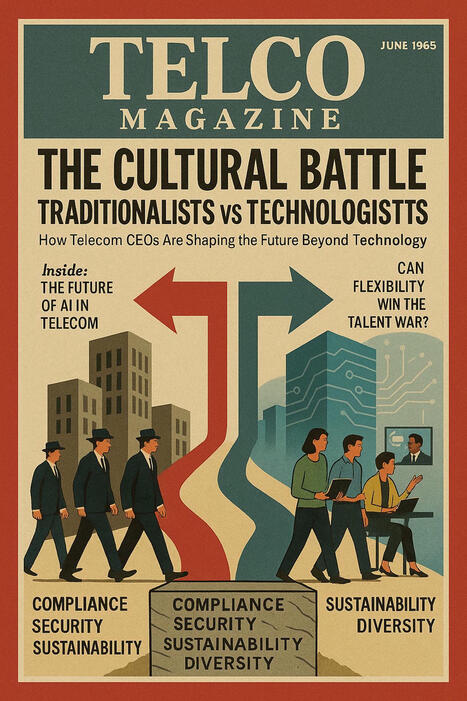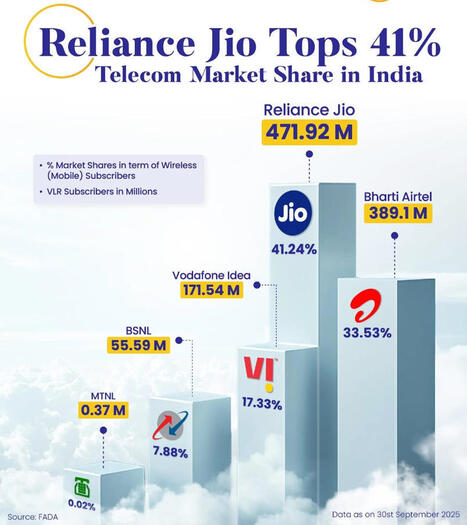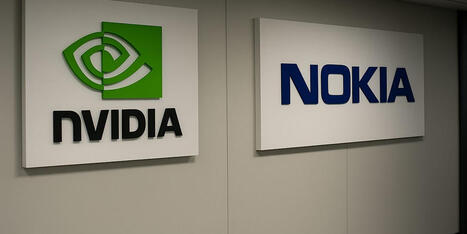 Your new post is loading...
 Your new post is loading...

|
Scooped by
Beeyond
January 9, 7:39 AM
|
Over the past weeks, I have had long private conversations with five senior telecom analysts. The reason is because I was a dissapointed about many of the latest reports I saw regarding 2026. trends They felt just corporate talk or even sponsored reports. So I wanted to have a honest discussion. What came out of those discussions has very little to do with the trend reports filling our inboxes right now. Those documents are written to keep ecosystems stable, relationships smooth, and marketing budgets justified. This was different. This is where the industry is structurally weak and where 2026 will prompt uncomfortable discussions.
This is not a future-looking hype piece and not a technology wish list. It is a confession-style assessment of what actually matters next year, based on what people say when they stop selling and start thinking.

|
Scooped by
Beeyond
January 6, 2:55 AM
|
Mature assets, strong incumbents, high technical competence, and slow decision cycles. In that environment, advantage no longer comes from owning better infrastructure. It comes from how effectively the organization coordinates what it already owns. Analysts consistently find that, after asset normalization, operating model and decision velocity account for roughly 30-40% of performance variance. Network quality explains survival but does not explain outperformance. Once technical parity is reached, internal friction becomes the dominant tax. Culture here is not about kindness or slogans. It concerns incentives, permissions, ways of working, and coherence.

|
Scooped by
Beeyond
January 2, 6:42 AM
|
Starlink’s decision also comes after the company disclosed in December that one of its satellites suffered an in-orbit anomaly, producing a “small” amount of debris and cutting off communications with the spacecraft at an altitude of about 260 miles. The company said the satellite, one of nearly 10,000 currently in orbit for its broadband internet network, rapidly lost 2.49 miles in altitude, suggesting an internal explosion, in what was described as a rare kinetic accident.

|
Scooped by
Beeyond
December 6, 2025 11:31 AM
|
The next decade forces telecom to abandon human centric assumptions and design a network that can support continuous inference, real time robotics and machine generated traffic at global scale.

|
Scooped by
Beeyond
November 30, 2025 8:46 AM
|
A direct look at the hidden assumptions shaping telco strategy and the truths buried beneath them

|
Scooped by
Beeyond
November 18, 2025 11:26 AM
|
Every week, I collect private confessions from telco CXOs. This time, I pulled together fifteen short stories. Small moments that expose the truths our industry keeps quiet. Real voices. Real pressure. Real mistakes. Real opportunities. A clearer picture of telco emerges one confession at a time. A collection of honest reflections from the people who actually run networks and see the industry from the inside every day.

|
Suggested by
Sidra Jefferi
November 5, 2025 3:23 PM
|
Many avid travelers, campers, and RVers settle on satellite Internet as a solution to the losses in connectivity they experience while traveling through rural and highly remote areas of the United States. However, depending on your needs, satellite Internet plans can be too pricey to be practical. Furthermore, satellite Internet often comes with problems such as high latency and data caps. Before you search for “satellite internet providers near me” again, consider switching to renowned rural 5G/4G LTE Internet provider UbiFi.

|
Scooped by
Beeyond
October 29, 2025 7:37 AM
|
Telco used to be the most exciting place on Earth. We were the people who made the impossible happen. We connected continents, carried the first digital signals, and built mobile networks that turned communication into a human right. We were the engineers who bent physics to our will. Then something happened. We turned into administrators of connectivity. The industry that invented the digital age now spends more time in regulatory filings than in labs.

|
Scooped by
Beeyond
October 23, 2025 12:05 PM
|
Most telcos still haven’t come to terms with what AI truly means for their future. This is a 2007 iPhone moment on steroids, not another radio upgrade, not a “TechCo” rebrand, and certainly not a digital transformation checklist. AI is changing the very physics of how humans, and now machines, connect and interact across the digital and physical world.

|
Scooped by
Beeyond
October 13, 2025 8:56 AM
|
This week, the confession comes from the other side of the table. From the people who have built our systems, sat through our meetings, and quietly watched the same story repeat across continents: the vendors.
They have seen how decisions are made, how timelines are invented, and how politics replaces logic. They know when a project will fail before the first contract is signed. They understand that most telcos no longer innovate; they negotiate. Procurement has replaced product. Compliance has replaced creativity.

|
Scooped by
Beeyond
August 27, 2025 7:54 AM
|
Post-COVID, telcos share a baseline of compliance, security, and sustainability, but now split between traditionalist office-first cultures and technologist AI-first models.

|
Scooped by
Beeyond
August 13, 2025 10:45 AM
|
Three independent models, grounded in public data and two decades of telecom experience, to estimate the real cost of building 6G.

|
Scooped by
Beeyond
October 27, 2024 3:06 PM
|
Les objets connectés s'installent peu à peu dans les foyers français. Selon une enquête menée par reichelt elektronik et OnePoll, 56 % des ménages en France possèdent au moins un appareil intelligent chez eux. Toutefois, les Français affichent un certain retard par rapport à leurs voisins européens. Malgré ces chiffres, les Français restent optimistes quant aux bénéfices des maisons intelligentes, en particulier pour le confort et les économies d'énergie.
|

|
Scooped by
Beeyond
January 8, 9:20 AM
|
Since 2000, telecommunications operators have paid approximately $1 trillion for spectrum access. Not equipment. Not fiber. Not radios. Just permission to transmit. Roughly $400–450B upfront in primary license awards, $50–100B in clearing and refarming, and hundreds of billions more in recurring spectrum fees paid every year. This is the largest capital and rent extraction in telecom history.

|
Scooped by
Beeyond
January 4, 5:05 AM
|
The idea that telecom networks can be used for weather sensing is not new. GNSS-based atmospheric estimation, rain attenuation on microwave links, and radio refractivity effects have been studied for more than 20 years. The physics is well understood and already embedded in network planning and synchronization systems.

|
Scooped by
Beeyond
December 11, 2025 5:53 AM
|
La proposition a pris corps mercredi avec la publication d’un avis au Federal Register, le Journal officiel américain : l’administration Trump veut désormais exiger des visiteurs bénéficiant du programme d’exemption de visa (ESTA) qu’ils fournissent l’historique de leurs comptes sur les réseaux sociaux sur cinq ans.

|
Scooped by
Beeyond
December 4, 2025 5:00 AM
|
Why Telcos Are Spending Billions on Transformation, Only to Feed the Ghost of Yesterday... The industry is not just underperforming; it is actively using its massive capital expenditure to service the maintenance and complexity of its own past, leading to a permanent state of diminishing returns. The key challenge we are facing is that the problem is not the telco’s technology stack; it is the telco’s DNA.

|
Scooped by
Beeyond
November 20, 2025 8:11 AM
|
India’s telecom market behaves like a digital continent. It carries volumes that rival entire regions, yet it runs on the lowest revenue per user among major economies. Two operators deliver world-class network performance at a national scale, one operator remains structurally distressed, and a state player anchors policy goals. This mix of extreme usage, thin margins, and relentless investment pressure creates a system that is both remarkable and unstable.

|
Scooped by
Beeyond
November 16, 2025 2:05 PM
|
The reason these collisions keep appearing is that WiFi and cellular no longer occupy separate roles. They chase the same physics, the same mid-band capacity, the same enterprise environments, and the same edge compute opportunities. The Brussels decision is only the most recent signal that the two stacks are converging on the same territory, and every time that happens, the tension becomes visible.

|
Scooped by
Beeyond
November 3, 2025 3:59 AM
|
For more than a decade, the telecom industry has been busy trying to reinvent itself as something it is not. “Techco,” “Servco,” “Digital Operator”, all elegant slogans for an age that believed value came from software and platforms. Telcos sold towers, outsourced data centers, and trimmed engineering ranks to chase cloud partnerships and brand adjacency. It looked modern; it was strategically backward. While telcos were distancing themselves from hardware, the world quietly re-industrialized. AI transformed computing from a software abstraction into a physical process, a factory operation that consumes electricity, produces tokens, and generates cognition. The bottleneck is no longer spectrum or subscriber growth but the energy-to-intelligence ratio: how many joules it takes to deliver a decision. Every major technology company is now an energy company in disguise. Global CapEx tells the story.

|
Scooped by
Beeyond
October 28, 2025 1:09 PM
|
When Nvidia takes a billion-dollar stake in an old-guard telecom vendor, it’s not a financial gesture but a signal. A signal that the AI arms race is moving from datacenters into the network fabric itself. On October 28, 2025, Nokia announced that Nvidia will invest $1 billion in newly issued shares, acquiring roughly 166 million shares, or about 3.5% of the company, and forming a deep strategic alliance to co-develop 6G and AI-native networking technologies. Nokia’s stock jumped 18 % within hours.

|
Scooped by
Beeyond
October 20, 2025 11:12 AM
|
Before 2007, Telcos knew precisely who they were.
They built networks. They connected nations. They carried the weight of communication with pride. Telcos were infrastructure institutions: disciplined, engineered, predictable.
Then, in 2007, everything changed. The iPhone turned connectivity into an afterthought. The network disappeared behind the screen, and the center of gravity shifted from infrastructure to experience. For the first time, the telco wasn’t the main act; it was the invisible stagehand behind the digital revolution.

|
Scooped by
Beeyond
October 8, 2025 11:30 AM
|
Telco CEOs have changed as much as the networks they run. Two decades ago, most were engineers obsessed with coverage maps; today, they’re diplomats managing politics, investors, and cloud partners.

|
Scooped by
Beeyond
August 19, 2025 6:55 AM
|
J’ai testé pour vous pendant un mois le Minimal Phone — ce smartphone e-paper à clavier physique. Je voulais savoir si la combinaison d’un écran papier noir et blanc, d’un clavier physique et d’Android était une option viable pour reprendre en main sa vie numérique dans l’esprit de l’accompagnement que propose TeleCoop à ses abonnés mobile.

|
Scooped by
Beeyond
August 8, 2025 9:07 AM
|
In recent years, the revolutionary field of immunotherapy has drastically reshaped the landscape of cancer treatment, pushing the boundaries of what modern medicine can achieve. Among these advancements, Chimeric Antigen Receptor (CAR) T-cell therapy stands out as one of the most promising strategies that could redefine the future of cancer eradication. Building upon decades of immunological research, this innovative therapy harnesses the very cells of the immune system to specifically target and eliminate malignant cells, offering new hope to patients with otherwise refractory cancers.
|

 Your new post is loading...
Your new post is loading...
 Your new post is loading...
Your new post is loading...


































